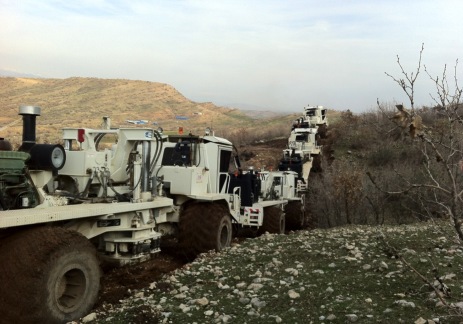
Introduction
We present a robust reverse-time-migration approach for imaging vertical seismic profiles.
With this method it is possible to calculate time-shift, depth-shift, and angle gathers
for immediate validation of the propagation parameters in the vicinity of the borehole.
It makes full waveform inversion of vertical seismic profiles (VSP) straightforward.
Through a densely sampled 2D walkaway synthetic, we show that full waveform inversion
is a viable process for extraction of near borehole model properties.
Applying our process to synthetic anisotropic data verifies the extensibility of the process to complex media.
The ability to produce angle gathers means that we can utilize prestack inversion methods to enhance extraction of reservoir properties.
We demonstrate that our method produces higher quality results then traditional wavefield separation approaches even in cases where the borehole is poorly sampled.
Traditional VSP Processing
Modern processing of
VSP's has remained static for many years. Wave
field separation is applied to estimate upward
and downward traveling waves at the borehole
which are then used to obtain subsurface images.
The utility of this approximate separation is
best for "rig-source" non-deviated wells, but
loses meaning rapidly in the presence of deviated
wells and offset VSPs.
We concluded that this
methodology did not provide anything close to the kind of image
quality that should be possible.
Panorama VSP Processing
Our imaging process achieves a more complete separation of the wavefields into directional components,
and handles correlations between any two components of "source" and "receiver" wavefields
to produce a subsurface VSP image consistent with and highly correlated with surface reflection
measurements.
History of Panorama RTM/VSP Processing
In 2007, Panorama developed a new RTM imaging condition motivated by the desire to
improve amplitude response at high opening angles while avoiding well known RTM imaging artifacts.
Such artifacts are usually attenuated during post processing with a low wavelength filter.
The two problems are really one.
An angle domain imaging adjustment turned
out to be the solution.
Ultimately we discovered that our new approach also showed promise for
imaging seismic borehole data. Some modifications for
the unique VSP geometry resulted in a hands-free VSP imaging method that we call VSPRS.
Application of VSPRS to several full waveform inversion projects resulted
in superior results and thereby validated the
approach.
Success
High angle responses
are much more prevalent in VSP data then those
in surface measurements. As evident in the following
examples, large features such as
water bottoms, tops of salt, and others, are
entirely imaged in the high angle domain, so it is
crucial to accurately handle those amplitudes. We
consider our success with VSP imaging to be
a complete validation of our FWI approach.
The overall workflow is quite simple. The VSP is
sorted into either borehole receiver gathers or
surface shot gathers and then imaged using our version of reverse time
migration. This is equivalent to the migration of
traditional surface shot records which is quite
simple in concept. Moreover, as shown in the
following examples it is possible, but
computationally costly to produce time/depth shift and
angle gathers. However, these gathers are extremely useful because
they can directly impact subsurface parameter estimation and
further enhance the imaging process.
Summary
Our proprietary imaging algorithm gives more
accurate amplitudes and fewer artifacts,
and has been extended to VSP processing since
2013.
-
Traditional VSP processing approximately separates up- and down-going at borehole; directionality
of wavefield changes during propagation
-
RTM is capable of imaging any refraction-induced deviation.
-
Traditional approach can remove useful information.
-
VSPRS images every component within the VSP wavefield simultaneously.
-
No preprocess separation required.
-
VSPRS handles correlations between any two components of "source" and "receiver" wavefields.
-
VSPRS is a proprietary RTM-style process in which correlations between two modeled wavefields are made to yield the image.
Depending on available information (shear velocity, 3C input, etc.), shear (S) waves can also be handled
internally to the algorithm without need to separate them from compressional (P) waves.
